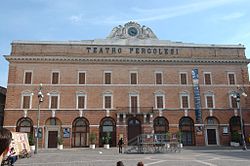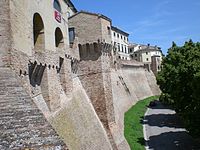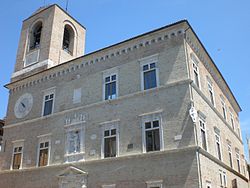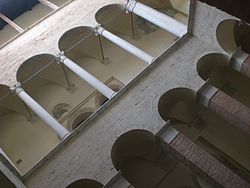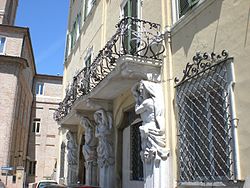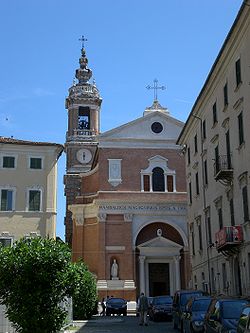- Iesi
-
Iesi — Comune — Città di Jesi
City of IesiRicci Palace in Iesi. 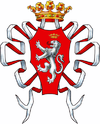
Coat of armsLocation of Iesi in Italy Coordinates: 43°31′25″N 13°14′21″E / 43.52361°N 13.23917°E Country Italy Region Marche Province Ancona (AN) Frazioni Mazzangrugno, Castelrosino, Tabano, Santa Lucia, Pantiere of Iesi Government - Mayor Fabiano Belcecchi (since May 28, 2002) Area - Total 107 km2 (41.3 sq mi) Elevation 97 m (318 ft) Population (June 30, 2008) - Total 40,008 - Density 373.9/km2 (968.4/sq mi) Demonym (Italian) iesini
(English) IesinsTime zone CET (UTC+1) - Summer (DST) CEST (UTC+2) Postal code 60035 Dialing code 0731 Patron saint St. Septimius Saint day September 22 Website Official website Iesi (Italian: Jesi) is a town and comune of the province of Ancona in the Marche, Italy.
It is an important industrial and artistic center in the floodplain on the left (north) bank of the Esino river 17 kilometres (11 mi) before its mouth on the Adriatic Sea.
Contents
History
Iesi was one of the last towns of the Umbri when, in the 4th century BC, the Senones Gauls invaded the area and ousted them. They turned it into a stronghold against the Piceni. In 283 BC the Senones were defeated by the Romans. Iesi in 247 BC became a colonia civium romanorum with the name of Aesis.
During the fall of the Western Roman Empire, Iesi was ravaged by the troops of Odoacer (476 AD) and again in 493 by the Ostrogoths of Theodoric the Great. After the Gothic War, Italy became part of the Byzantine Empire, and Iesi became one of the main centers of the new rulers, and also became a diocese seat. In 751 it was sacked by the Lombard troops of Aistulf, and later was a Carolingian imperial city.
Starting from 1130, it was an independent commune, gradually expanding in the neighboring countryside. In December 1194 it was the site of the birth of Holy Roman Emperor Frederick II,[1] who later gave it the title of "Royal City". In the 14th century it was captured by the Papal vicar Filippo Simonetti, by Galeotto I Malatesta (1347–1351), by Braccio da Montone in 1408, and by Francesco I Sforza, who turned it into his family's main stronghold in the Marche. In 1447 it was bought by the Papal States.
Main sights
- The Cathedral (Duomo), built in the 13th-15th centuries. The façade and the Latin cross interior are modern.
- Palazzo della Signoria, built in 1486-1498 by Francesco di Giorgio Martini. The angular tower was elevated in 1661 and received a dome, but crumbled down a few years later. Notable is the interior courtyard, with two orders of loggias, partially designed by Andrea Sansovino from 1519.
- Palazzo Balleani, an example of local Baroque architecture, built from 1720 and designed by Francesco Ferruzzi. The façade has a characteristic balcony supported by four atlases (1723). The interior has precious gilted stucco decoration.
- The convent of San Floriano (18th century).
- The 14th century walls, built following the line of the Roman ones and mostly rebuilt in the 15th century by Baccio Pontelli and Francesco di Giorgio Martini. Six towers remain today.
- Church of San Marco, just outside the historical centre. A Gothic architecture, it was erected in the 13th century. The interior has a nave and two aisles, with a 14th century fresco of Rimini's school.
- Palazzo Ricci, finished in 1547. The diamond-like bricks of the façade are inspired to famous Palazzo dei Diamanti in Ferrara.
- Teatro Pergolesi, built in 1790.
- Palazzo Pianetti, one of the most outstanding examples of Italian Roccoco art. The wide façade has exactly one hundred windows, while the interior has a noteworthy giardino all'italiana. The palace houses city's civic art gallery, with a series of paintings by the Venetian artist Lorenzo Lotto.
- The church of Santa Maria delle Grazie (15th century). The belltower is from the 17th century.
- The 13th century church of San Nicolò. It has a Romanesque apse and a Gothic portal.
Natives of Iesi
- Frederick II, Holy Roman Emperor
- Giancarlo Aquilanti
- Giancarlo Falappa
- Virna Lisi
- Roberto Mancini
- Antonio Magini-Coletti
- Valeria Moriconi
- Giovanni Battista Pergolesi
- Paolo Polidori
- Rafael Sabatini
- Giovanna Trillini
- Valentina Vezzali
Sister cities
Sources
- ^ Norwich, John Julius. Byzantium: The Decline and Fall (New York: ALfred A. Knopf, p. 162
External links
Marche · Comuni of the Province of Ancona Agugliano · Ancona · Arcevia · Barbara · Belvedere Ostrense · Camerano · Camerata Picena · Castel Colonna · Castelbellino · Castelfidardo · Castelleone di Suasa · Castelplanio · Cerreto d'Esi · Chiaravalle · Corinaldo · Cupramontana · Fabriano · Falconara Marittima · Filottrano · Genga · Iesi · Loreto · Maiolati Spontini · Mergo · Monsano · Monte Roberto · Monte San Vito · Montecarotto · Montemarciano · Monterado · Morro d'Alba · Numana · Offagna · Osimo · Ostra · Ostra Vetere · Poggio San Marcello · Polverigi · Ripe · Rosora · San Marcello · San Paolo di Jesi · Santa Maria Nuova · Sassoferrato · Senigallia · Serra San Quirico · Serra de' Conti · Sirolo · StaffoloCategories:- Cities and towns in the Marche
- Communes of the Province of Ancona
Wikimedia Foundation. 2010.



